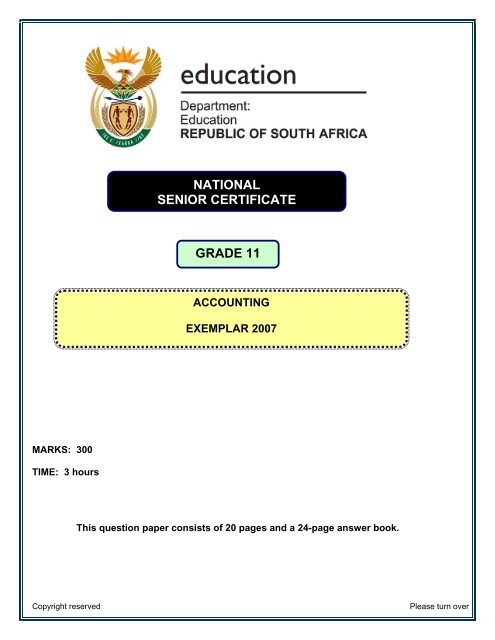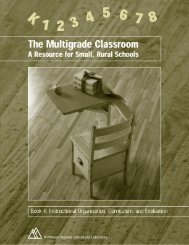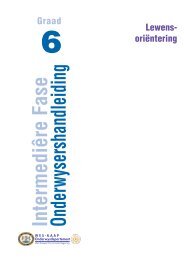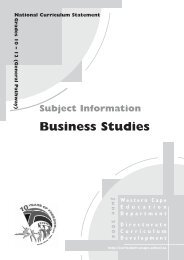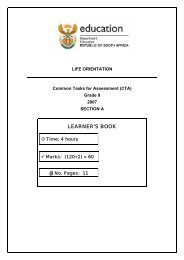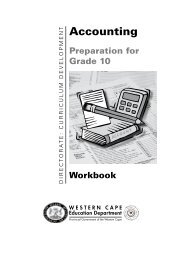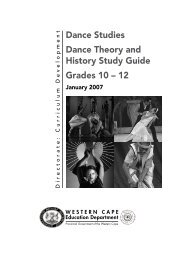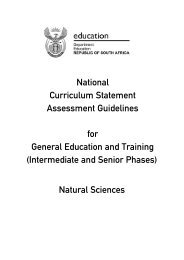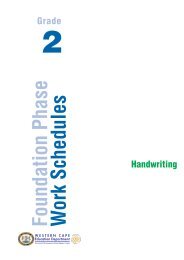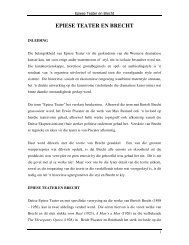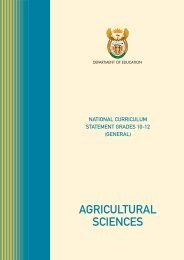NATIONAL SENIOR CERTIFICATE GRADE 11
NATIONAL SENIOR CERTIFICATE GRADE 11
NATIONAL SENIOR CERTIFICATE GRADE 11
You also want an ePaper? Increase the reach of your titles
YUMPU automatically turns print PDFs into web optimized ePapers that Google loves.
<strong>NATIONAL</strong><strong>SENIOR</strong> <strong>CERTIFICATE</strong><strong>GRADE</strong> <strong>11</strong>ACCOUNTINGEXEMPLAR 2007MARKS: 300TIME: 3 hoursThis question paper consists of 20 pages and a 24-page answer book.Copyright reservedPlease turn over
Accounting 2DoE/Exemplar 2007NSCINSTRUCTIONS AND INFORMATION1. You are provided with a question paper and an answer book.2. The paper comprises SEVEN compulsory questions. Answer ALL these questions.3. Use the formats provided in order to reflect your answers.4. Workings must be shown in order to achieve part-marks.5. You must attempt to comply with the suggested time allocations.6. Non-programmable calculators may be used.7. You may use a dark pencil or blue/black ink to answer the questions.Copyright reservedPlease turn over
Accounting 3DoE/Exemplar 2007NSC<strong>GRADE</strong> <strong>11</strong>ACCOUNTINGEXEMPLAR 2007QUESTION 1: 40 marks; 25 minutesThe topic of the question is: The learning outcomes covered are:Cash budgetLO2 Managerial accounting• AS3 Prepare and present a cash budgetLO3 Managing resources• AS4 Identify & analyse ethical behaviourQUESTION 2: 45 marks; 25 minutesThe topic of the question is: The learning outcomes covered are:ManufacturingLO2 Managerial accounting• AS2 Apply costing in manufacturing environment andrecord in ledger• AS2 Unit costs & break-evenQUESTION 3: 40 marks; 25 minutesThe topic of the question is: The learning outcomes covered are:Partnership financial statementsLO1 Financial information• AS5 Financial statements – partnershipsQUESTION 4: 40 marks; 25 minutesThe topic of the question is: The learning outcomes covered are:Fixed assets & internal auditLO3 Managing resources• AS3 Depreciation, acquisition & disposal of assets• AS5 Identify & analyse ethical behaviour• AS6 Internal audit/control processesLO1 Financial information• AS5 Note to financial statementsQUESTION 5: 50 marks; 30 minutesThe topic of the question is: The learning outcomes covered are:Partnership analysis & interpretationLO1 Financial information• AS5 Analysis and interpretation of financial statements ofpartnershipsLO3 Managing resources• AS5 Identify & analyse ethical behaviourQUESTION 6: 50 marks; 30 minutesThe topic of the question is: The learning outcomes covered are:Stock systems & VATLO3 Managing resources• AS4 Periodic inventory system• AS6 Internal audit/control processesLO1 Financial information• AS2 Selected ledger accounts• AS7 Perform VAT calculationsQUESTION 7: 35 marks; 20 minutesThe topic of the question is: The learning outcomes covered are:Club fees & bank reconciliationLO1 Financial information• AS2 Unique information of a club• AS4 Bank reconciliation• AS6 Internal audit control processesCopyright reservedPlease turn over
Accounting 4DoE/Exemplar 2007NSCQUESTION 1 CASH BUDGET (40 marks: 25 minutes)You are provided with information of Jaycee Supermarket, a business owned byJohnny Christofides.Johnny is worried about his poor cash flow situation at the end of September. Inorder to rectify the situation, Johnny plans to prepare a Cash Budget and toincrease his mark-up percentage.REQUIRED:1.1 Prepare the Debtors' Collection Schedule for October and November 2007.ALL calculations must be rounded off to the nearest rand. (7)1.2 Complete the Cash Budget for October and November 2007. Johnny hascompleted some of the October figures for you. ALL calculations must berounded off to the nearest rand. (19)1.3 At the end of November the total sales for October and November areR380 000. Should Johnny be satisfied with this? Explain, and state TWOfactors that Johnny should consider in assessing this figure. Quotefigures/financial indicators to support your answer. (5)1.4 The employees feel that the remuneration policy of this business is unfair,that is, they are not satisfied with their earnings. Do you agree with them?Provide figures from the question to determine whether their opinion is validor not. State TWO reasons to support your answer. (5)1.5 Name TWO strategies that Johnny could consider in December to improvehis cash flow. Give a reason for each strategy. (4)INFORMATION:1. Johnny currently uses a mark-up of approximately 52% on cost, but he plansto increase this to 75% from 1 October 2007.2. Extracts from the ledger for the past year ended 30 September 2007:Sales R 2 332 800 (distributed evenly over the year)Cost of sales 1 536 000Trading stock 324 000Loan from A1 Lenders 90 000 (interest rate 14% p.a.)Bank overdraft 28 000Copyright reservedPlease turn over
Accounting 5DoE/Exemplar 2007NSC3. Cash sales comprise 20% of all sales. Johnny predicts total sales and cost ofsales to be the following:October NovemberTotal sales R210 000 R245 000Cost of sales R120 000 R140 000Mark-up % 75% 75%4. Debtors are expected to settle their accounts as follows:• 50% in the month following the sales transaction month (that is, within30 days). These debtors are entitled to 5% cash discount for promptsettlement.• 44% in the second month following the sales transaction month (thatis, within 60 days).• 6% will be written off as bad debts.5. Purchase of trading stock:• Trading stock is kept at a constant level. (Purchases replace sales inthe same month.)• All purchases of merchandise are for cash.6. Loan from A1 Lenders:The short-term loan was originally received on 30 September 2007. This is tobe repaid in equal instalments over 24 months on the last day of each month.Interest at 14% p.a. is also paid on the last day of each month.7. On 1 November 2007, the salary of the shop manager will increase by 12%,while the wages of the six shop assistants will increase by R120 each.40Copyright reservedPlease turn over
Accounting 6DoE/Exemplar 2007NSCQUESTION 2 MANUFACTURING ACCOUNTS (45 marks; 25 minutes)2.1 You are provided with the following information for Buggy’s BagManufacturers for the year ended 28 February 2007. This is an after-hourspart-time business for Buggy.REQUIRED:Study the information provided and answer the questions which follow.INFORMATION:1. Buggy produced and sold 1 500 bags during the year.2. No stocks were on hand at the beginning or end of the financial period.3. His costs for the year are shown below. He regards certain costs as fixedand others as variable.QUESTIONS:Cost: Amount: Cost category:Administration cost R 10 000 FixedDirect material cost 34 500 VariableDirect labour cost 28 500 VariableFactory overhead cost 23 100 FixedSelling & distribution cost 12 300 VariableTotal costs R108 400Sales R153 000Net profit R44 6002.1.1 Calculate the following:• Direct materials cost per unit• Variable costs per unit• Selling price per bag (7)2.1.2 How many bags must Buggy make in order to break even (that is, toearn no profit or suffer a loss)? (6)Copyright reservedPlease turn over
Accounting 7DoE/Exemplar 2007NSC2.2 You are provided with information relating to Thabo’s T-shirtManufacturers. The information given below was extracted from theaccounting records on 28 February 2007, the end of the financial year.REQUIRED:Answer the following questions: Balance/Close off ALL accounts on28 February 2007.2.2.1 Prepare the Raw Materials Stock Account in the ledger. (8)2.2.2 Calculate factory overhead cost for the year. (8)2.2.3 Prepare the Work-in-process Stock Account in the ledger. (10)2.2.4 Calculate the finished goods stock on hand at the end of the year. (6)Balances on 1 March: 2006 2007Raw materials stock R 24 000 R 16 500Work-in-process stock 17 800 23 400Finished goods stock 22 500 ?Indirect factory materials stock 1 200 1 500Summary of transactions for the year ended 28 February 2007:Sales R 974 204Raw materials bought on credit 266 000Raw materials bought for cash 103 000Wages of direct labourers <strong>11</strong>0 600Salaries & wages – factory indirect workers 122 000Salary of bookkeeper/receptionist 35 200Motor vehicle expenses (all vehicles are used by salesmen) 36 000Water and electricity (to be apportioned between the factoryand the office in the ratio 4:1) 26 200Indirect factory materials bought on credit during the year 18 000Sundry factory expenses 43 100Additional information:1. Finished T-shirts were sold at a mark-up of 40% on cost ofproduction.2. Sundry factory expenses of R1 300 have been prepaid at the yearend.45Copyright reservedPlease turn over
Accounting 8DoE/Exemplar 2007NSCQUESTION 3 FINANCIAL STATEMENTS (40 marks; 25 minutes)You are provided with information relating to Tultim Traders. The business is apartnership owned by Thulani Themba and Tim Taylor.REQUIRED:3.1 Complete the note to the Balance Sheet for the Current Accounts on28 February 2007. A total column is not required. Tim’s figures have beenentered for you. (13)3.2 Prepare the Balance Sheet on 28 February 2007. Where notes are notrequired, show your workings in brackets on the face of the Balance Sheet. (27)INFORMATION:1. Figures identified from the Trial Balance on28 February 2007:Capital: Thulani 400 000Capital: Tim 400 000Current account: Thulani (1 March 2007) Debit 22 000Current account: Tim (1 March 2007) Credit 15 000Drawings: Thulani ?Drawings: Tim ?Mortgage loan: Gauteng Mortgages ?Fixed assets – book value 1 020 000Fixed deposits at Bildco <strong>11</strong>0 000Bank overdraft 46 000Cash float 5 000Inventories ?Trade & other receivables ?Creditors' control 172 000SARS (PAYE) 20 000Copyright reservedPlease turn over
Accounting 9DoE/Exemplar 2007NSC2. Information concerning partners’ earnings and drawings:• Tim earns a partner’s salary of R12 000 per month, while Thulani earns25% more than Tim.• Interest on capital is 9% p.a. Note that Thulani had increased his capitalby R100 000 on 1 December 2006 (this has been recorded).• Remaining profits are shared between Thulani and Tim in the ratio 3:2respectively. The remaining profit earned by Tim after all adjustmentsand after the internal audit was calculated to be R240 000.• Tim withdrew 75% of his earnings for the 2007 financial year.• Thulani has a personal cash flow problem. In consultation with Tim, hewithdrew as much as possible, leaving a positive balance of R50 000 inhis current account at the end of the year.3. Additional information:• Information from loan statements for the year ended 28 February 2007:- Balance on 1 March 2006: R360 000- Interest charged by Gauteng Mortgages: R45 600- Monthly payments to Gauteng Mortgages: R5 300 per month- During the next 12 months, the capital amount of the mortgage loanwill decrease by R22 000• There are two fixed deposits at Bildco:- A fixed deposit for R80 000 matures on 30 June 2009- A fixed deposit for R30 000 matures on 30 June 2008• On 28 February 2007, the current ratio is 1,8:1 and the acid-test ratio is0,7:1.40Copyright reservedPlease turn over
Accounting 10DoE/Exemplar 2007NSCQUESTION 4 FIXED ASSETS & INTERNAL AUDIT (40 marks; 25 minutes)4.1 RECORDING AND REPORTING OF FIXED ASSETSYou are provided with information relating to Maduna & Son Traders.REQUIRED:4.1.1 Calculate depreciation on vehicles for the year ended 28 February2007. (7)4.1.2 Prepare the Asset Disposal Account on 31 December 2006. (9)4.1.3 Complete the note to the Balance Sheet for fixed assets on 28February 2007. A total column is not required. Some of the figureshave already been entered for you. (13)INFORMATION:1. Depreciation on vehicles is calculated at 20% p.a. on the straight-linemethod. Depreciation on equipment for the year amounts to R<strong>11</strong> 400.2. The following balances appeared in the ledger on 1 March 2006:• Vehicles, at cost R880 000• Accumulated depreciation on vehicles, R250 000• Equipment, at cost R336 000• Accumulated depreciation on equipment, R257 0003. Bought new equipment on credit for R105 000 on 1 November 2006.4. Paid Urban Technics the following on 28 February 2007:• R8 000 for installing a sound system in a vehicle• R3 000 for repairing the air-conditioning system in the vehicle5. Traded in a vehicle at Pretoria Motors on 31 December 2006. The trade-invalue offered by Pretoria Motors was R32 000, while the cost of the newvehicle was R180 000. The balance of R148 000 due to Pretoria Motors willbe paid over the next 6 months.Details of the old vehicle traded in were obtained from the Fixed AssetsRegister:FIXED ASSETS REGISTERVehicle: Toyota Corolla Model: 2003Date bought: 1 May 2003 Date sold: 31 Dec. 2006Cost price: R144 000Depreciation written off:28 Feb. 2004 R24 00028 Feb. 2005 R28 80028 Feb. 2006 R28 800R81 60031 Dec. 2006 ?Copyright reservedPlease turn over
Accounting <strong>11</strong>DoE/Exemplar 2007NSC4.2 INTERNAL CONTROL AND INTERNAL AUDIT OF FIXED ASSETSYou are provided with an extract of a newspaper article. The names and details havebeen altered as the case has not yet been finalised.REQUIRED:Read the article and then answer the questions which follow:ASSETS OF BROTHERS ON FRAUDCHARGES FROZENBased on an article by Tania Broughton,Independent Newspapers, 7 Nov. 2006.Houses, a holiday home, cars and cash belonging totwo brothers accused of fraud involving more thanR3,6 million were ‘preserved’ by a Durban HighCourt judge on Friday, pending the outcome ofcriminal proceedings against them.Should John Jones* and his brother, James Jones*,be found guilty of the charges, an application willbe made to have their assets forfeited to the state.According to legal papers before Judge BraamSchreuder*, the two brothers were employed asmanagers by Grimebusters*, a curtain and carpetcleaning business. They have both since resigned.Wilfred Moolman*, the head of the Asset ForfeitureUnit, said as a result of a police investigation, thepair had been arrested in July and charged withfraud, alternatively theft. They intended to plead notguilty.He said the investigation revealed that whileemployed at Grimebusters* they had formed acurtain and carpet cleaning business trading as JJCleaners*.‘They allocated Grimebusters* staff, equipment andstock to conduct curtain and carpet cleaningservices for various customers of JJ Cleaners*.‘They then created invoices containing the nameand banking details of JJ Cleaners* and paymentswere made into that account,’ he said.He alleged that as a result of this, R3 627 000 hadbeen paid into the account of their own business,which has caused loss to Grimebusters*.According to the court order, which was made byconsent, the brothers had to surrender cash ofR877 000 which is being held in trust by a lawyer, ahouse in Durban, a flat in Margate, a house inPinetown, four vehicles and three trailers.* Names altered.QUESTIONS:4.2.1 Briefly describe the crime of which the two brothers are accused. (3)4.2.2 In your opinion, is it right that the personal assets of the brothers beconfiscated if they are found guilty? Briefly explain. (2)4.2.3 If you were appointed as internal auditor of Grimebusters, whatprocedures or checks would you establish in the business to prevent thistype of crime from occurring in future? Name THREE points. (6)40Copyright reservedPlease turn over
Accounting 12DoE/Exemplar 2007NSCQUESTION 5 INTERPRETATION OF INFORMATION (50 marks; 30 minutes)You are provided with information relating to Imphala Electronics. The business is owned bytwo partners, Ian Impey and Peter Phala.REQUIRED:Study the information and answer the questions which follow. In support of your answers youmust quote figures and/or the actual financial indicators (ratios/percentages) where appropriate.INFORMATION:The following information was extracted from the ledger on 28 February 2007:CAPITAL: PHALA2007Mar. 1 Balance b/d 900 000Aug. 31 Bank 800 0001 700 0002007Feb. 28CURRENT ACCOUNT: PHALADrawings:2006Phala 77 000 Mar. 1 Balance b/d 40 0002007Balance c/d 90 000 Feb. 28 Salary: Phala 70 000Interest oncapital 48 000Appropriationaccount 9 000167 000 167 0002007Mar. 1 Balance b/d 90 000The following figures were extracted from the Balance Sheet on 28 February 2007:2007 2006Fixed assets 3 052 000 2 270 000Investments 150 000 180 000Current assets 850 000 720 000TOTAL ASSETS 4 052 000 3 170 000Owners’ equity 2 732 000 2 330 000Non-current liabilities (14% p.a.) 1 000 000 600 000Current liabilities 320 000 240 000TOTAL EQUITY & LIABILITIES 4 052 000 3 170 000Copyright reservedPlease turn over
Accounting 13DoE/Exemplar 2007NSCAmounts obtained from the financial statements:2007 2006Sales (40% on credit) 3 100 000 4 200 000Cost of sales 1 820 000 2 640 000Operating profit 365 800 600 600Net profit 269 000 520 000Capital – Impey 1 000 000 1 400 000Capital – Phala 1 700 000 900 000Current Account – Impey (58 000) (10 000)Current Account – Phala 90 000 40 000Trading stock 180 000 440 000Trade debtors 410 000 230 000Trade creditors 245 000 184 000Financial indicators calculated from the financial statements:2007 2006Operating profit as a % of sales <strong>11</strong>,8% 14,3%Net profit as a % of sales 8,6% 12,2%Current ratio 2,6:1 3,0:1Acid-test ratio 2,1:1 1,2:1Stock turnover rate 5,9 7,0Debtors' average collection period ? 54 daysCreditors average payment period 23 days 25 daysSolvency ratio ? 3,4:1Debt/Equity ratio ? 0,26:1Return on total capital employed 10,1% <strong>11</strong>,2%% return on average equity 12,9% 17,1%% return earned by Impey 14,7% 16,6%% return earned by Phala ? 17,3%Copyright reservedPlease turn over
Accounting 14DoE/Exemplar 2007NSCQUESTIONS:5.1 Solvency:5.1.1 Calculate the ratio of total assets to total liabilities for 2007. (3)5.1.2 Comment on this ratio. Is this business likely to experience asolvency problem? Briefly explain. (3)5.2 Gearing and profitability:5.2.1 Calculate the debt/equity ratio for 2007. (3)5.2.2 Phala is not happy with the debt/equity ratio and feels that it isnegatively affecting the performance of the business. State TWOpoints to support her opinion. (6)5.3 Returns and equity:5.3.1 Calculate Phala’s % return on average equity. (5)5.3.2 Phala is of the opinion that her return is unsatisfactory and thatImpey is taking advantage of his senior position in the partnership.State THREE points to support Phala’s opinion. (9)5.4 Liquidity:5.4.1 Calculate the debtors average collection period for 2007. (5)5.4.2 The customers are complaining that the business seldom stocks themodels or styles that they would like to buy. Which figures andfinancial indicators provide proof of this problem? Briefly explain.State TWO points. (4)5.4.3 The partners disagree about the liquidity situation.• Impey is not worried about the liquidity situation for theimmediate future.• Phala feels that there are danger signs for the long-termsustainability of the business as far as liquidity and cash flow areconcerned.State TWO points to support Impey’s opinion and TWO points tosupport Phala’s opinion. (12)50Copyright reservedPlease turn over
Accounting 15DoE/Exemplar 2007NSCQUESTION 6 STOCK SYSTEMS, CONTROL AND VAT (50 marks; 30 minutes)6.1 PERPETUAL (CONTINUOUS) INVENTORY SYSTEMYou are provided with information relating to Jaykay Jackets, a retail shop owned byJerry Kay. He uses the perpetual (continuous) inventory system. He is concerned thatthere has been shoplifting (theft of stock) in his business.INFORMATION:2007May 131Balance b/d 72 000LEDGER OF JAYKAY JACKETSTRADING STOCK2007May31 Creditors control CAJ 3 600Creditors control CJ 216 000 Cost of sales CRJ (a)Cost of sales DAJ 4 320 Drawings GJ (b)Trading stockdeficitGJ (c)Balance c/d ?292 320 292 3202007May 1Balance b/d ?ADDITIONAL INFORMATION:1. Jerry sells one type of jacket at a mark-up of 75% on cost. The cost price ofeach jacket is R360.2. There were 200 jackets on hand at the beginning of the month.3. Bought 600 jackets on credit during May.4. Sold jackets for cash. Cash slips issued to customers totalled R422 100.5. Returns of jackets were as follows:• Received credit notes totalling R3 600 for defective jackets returned tothe manufacturer.• Issued credit notes for R7 560 to credit customers. They returned 12jackets, as incorrect sizes had been sold to them.6. The owner took 8 jackets from stock for his family.7. A stock count on 31 May revealed that <strong>11</strong>3 jackets were on hand at the endof the month.REQUIRED:6.1.1 Refer to the Ledger Account above. Identify the missing figures reflected by(a), (b) and (c). (7)6.1.3 Does Jerry have a shoplifting or stock theft problem in his business? If so,how many jackets have gone missing? (3)Copyright reservedPlease turn over
Accounting 16DoE/Exemplar 2007NSC6.2 PERIODIC INVENTORY SYSTEMYou are provided with information relating to Mary’s Mugs, a retail shopowned by Mary Mbhele. She uses the periodic inventory system. She is alsoconcerned that there has been shoplifting.REQUIRED:6.2.1 Draw up a Trading Account for the month of July 2007. (16)6.2.2 Calculate the actual mark-up % on cost achieved for the month. (4)6.2.3 Does this calculation provide evidence that there is a shoplifting problem? Ifso, how serious is this problem? Quote figures or percentages to supportyour answer. (3)6.2.4 Mary has been told that it will be much better for her business to convert tothe perpetual inventory system. Do you agree? Briefly explain. (3)INFORMATION:1. Mary sells different types of coffee mugs. She aims at a mark-up of 50% oncost, but she does give trade discounts to special customers.2. Stock on hand at the beginning of the month, R120 000.3. Totals of source documents for the month:• Invoices received from manufacturers of mugs, R141 000.• Credit notes received for defective mugs returned to suppliers, R7 500.4. Paid Sky Couriers R3 500 for transporting mugs from overseas. Also paidcustoms duty of R4 800 on these mugs.5. Mary donated mugs to a local orphanage. The selling price of these mugs wasreflected as R9 600 on the price tags.6. All sales of mugs were for cash, R232 000. This was after granting tradediscounts of R8 000 to special customers.7. Stock on hand at the end of the month was valued at cost price, R95 400.Copyright reservedPlease turn over
Accounting 17DoE/Exemplar 2007NSC6.3 VATREQUIRED:You are provided with information relating to Jopa General Dealers.The business is owned by John Paulse and is registered as a VAT vendor.6.3.1 What is meant by input VAT and output VAT and how does thisaffect the payment made to SARS by a business? (2)6.3.2 Refer to the invoice below. Calculate the following:(a)(b)(c)(d)(e)(f)The amount of output VAT included in the R516,07The net selling price per packet of Powa breakfast cerealexcluding output VATThe cost of Powa breakfast cereal per packet excluding inputVATThe profit per packet of Powa breakfast cereal earned by thebusinessThe amount of input VAT per packet of Powa breakfast cerealThe amount of output VAT per packet of Powa breakfast cereal(2)(2)(2)(2)(2)(2)INFORMATION:1. Jopa General Dealers uses a secret cost code of ‘JOHNPAULSE’ where J=1.Input VAT is excluded when working out the cost code on each product.2. The following invoice is presented to you:JOPA GENERAL DEALERSInvoice: 7051Debit: Holly’s Bed & BreakfastPO Box 1234, Newlands23 June 2007COST VAT UNIT TOTALCODE RATE PRICE8 loaves brown bread N,NP 0% 5,30 42,4012 litres fresh milk H,LU 0% 4,56 54,7215 packets Powa breakfast cereal(1 kg)JA,NL 14% 27,93 418,95TOTAL R 516,07Signed: H Holly50Copyright reservedPlease turn over
Accounting 18DoE/Exemplar 2007NSCQUESTION 7 CLUB FEES & BANK RECONCILIATION (35 marks; 20 minutes)7.1 MEMBERSHIP FEESREQUIRED:You are provided with information relating to Ixopo Soccer Club.Study the information and answer the questions which follow.INFORMATION:1. The membership fees are R1 200 per year per member. The club had 51members at the end of the 2005 financial year.2. Members who do not settle their 2005 fees during the 2006 financial year arewritten off and expelled from the club.3. The following appeared in the Membership Fees Account for the year ended31 December 2006:Income accrued (receivable) on 1 Jan. 2006 R 17 400Income accrued (receivable) on 31 Dec. 2006 3 600Income received in advance (deferred income) on 1 Jan. 2006 2 400Income received in advance (deferred income) on 31 Dec. 2006 10 800Membership fees written off during 2006 4 800Membership fees received and banked during 2006 96 600Refunds to two members who retired from soccer on 30 Sept.due to injuries – they were each refunded one-third of their fees 800Error: Sponsorship received for overseas tour for the first team,incorrectly credited to Membership Fees Account 200 000QUESTIONS:7.1.1 How many members owe fees to the club at the end of the year? (2)7.1.2 How many members were expelled from the club during 2006 as aresult of unpaid fees? (2)7.1.3 What figure should appear in the 2006 Receipts & PaymentsStatement for membership fees? (2)7.1.4 What figure should appear in the 2006 Income & ExpenditureStatement for membership fees? (4)7.1.5 How many members were registered in the club on 31 December2006? (3)Copyright reservedPlease turn over
Accounting 19DoE/Exemplar 2007NSC7.1.6 The club president was very happy with the progress of the club at theend of 2006. Consider the figures provided in the question and stateTWO points to support his opinion. Quote the figures in your answer. (4)7.2 BANK RECONCILIATIONThe following information relates to Ixopo Soccer Club. The Treasurer hasfallen ill and has not completed the Bank Reconciliation Statement for the pasttwo months. He has, however, completed the Cash Receipts Journal (CRJ)and Cash Payments Journal (CPJ).REQUIRED:7.2.1 Calculate the bank balance on 1 July 2007. (4)7.2.2 Prepare and balance the bank account in the ledger for July 2007. (8)7.2.3 Prepare the Bank Reconciliation Statement on 31 July 2007 on the formatprovided. Cheques need not be itemised. (6)INFORMATION:1. On 31 May 2007 the bank account in the ledger reflected abalance of R22 500. This was identical to the balance on the bankstatement.2. Cheques recorded in the CPJ during June 2007: 17 500Recorded on bank statement in June 13 500Recorded on bank statement in July 3 650Recorded on bank statement in August 3503. Cheques recorded in the CPJ during July 2007: 47 500Recorded on bank statement in July 43 730Recorded on bank statement in August 3 7704. Deposits recorded in the CRJ in June 2007: 30 000Recorded on bank statement in June 27 400Recorded on bank statement in July 2 6005. Deposits recorded in the CRJ in July 2007: 40 000Recorded on bank statement in July 36 800Recorded on bank statement in August 3 200Copyright reservedPlease turn over
Accounting 20DoE/Exemplar 2007NSC6. Entries on the bank statement not recorded in the journals:June JulyDirect deposit made by a sponsor - 615Bank charges 65 90Direct deposit made by a member 400 400Dishonoured cheque from a member - 280Debit order for insurance 175 17535TOTAL: 300Copyright reserved


